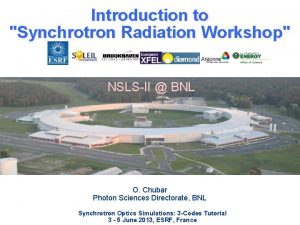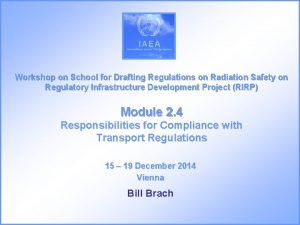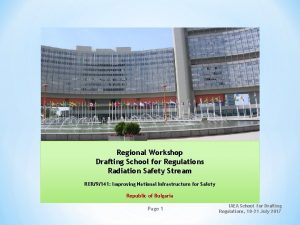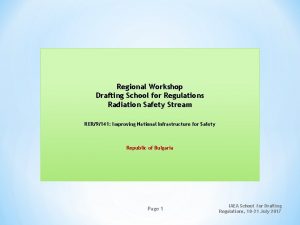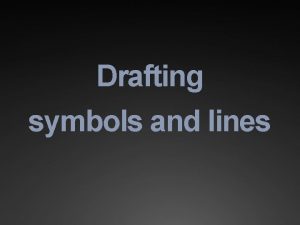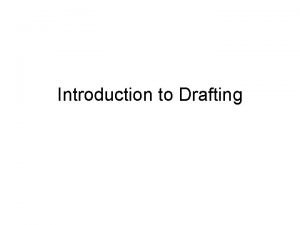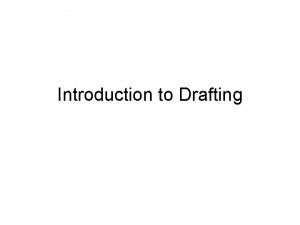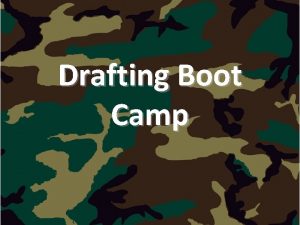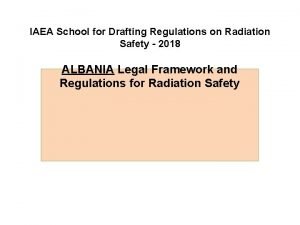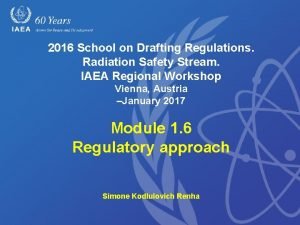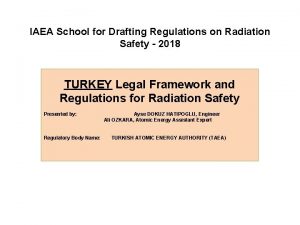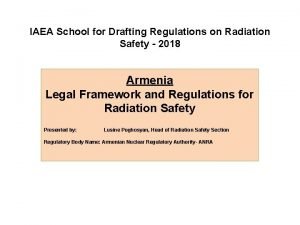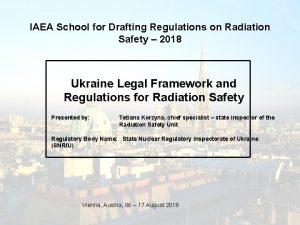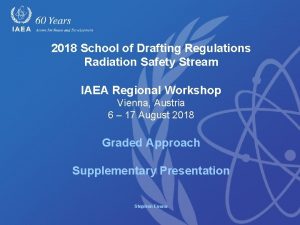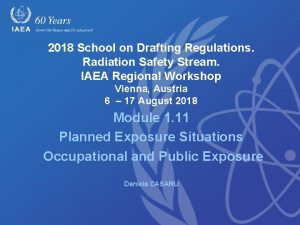Workshop on School for Drafting Regulations on Radiation

































































- Slides: 65

Workshop on School for Drafting Regulations on Radiation Safety on Regulatory Infrastructure Development Project (RIRP) Module 2. 2 The IAEA Transport Regulations 15 – 19 December 2014 Vienna Bill Brach

Presentation Overview END • IAEA Safety Standards • Including Transport Specific Safety Standards (requirements and guides) • Regulatory Infrastructure • Legislation/Regulations/Guidance • Review of Regulations for the Safe Transport of Radioactive Material (SSR-6) • Objectives and Scope • General Provisions with emphasis on radiation protection • Classification of material and packages • Package testing • General requirements for transport (e. g. , marking and labeling) • Additional requirements, controls and approvals 2 October 2020 Contents

IAEA Safety Standards END IAEA Safety Standards reflect an international consensus on what constitutes a high level of safety for protecting people and the environment from harmful effects of ionizing radiation October 2020 3 Contents

Safety Fundamentals SF-1 END The objective of SF-1 is to establish the fundamental safety objective, safety principles and concepts that provide the basis of the IAEA’s safety standards and its safety related programme. There are 10 Safety Principles Principle 1: Responsibility for safety Principle 2: Role of Government Principle 3: Leadership and management for safety Principle 4: Justification of facilities and activities Principle 5: Optimisation and protection Principle 6: Limitation of risks to individuals Principle 7: Protection of present and future generations Principle 8: Prevention of accidents Principle 9: Emergency preparedness and response Principle 10: Protective actions to reduce existing or unregulated radiation risks October 2020 4 Contents

General and Specific Safety Requirements END • General Safety Requirements (GSR): – – – – Part 1 Governmental, Legal and Regulatory Framework for Safety Part 2 Leadership and Management for Safety Part 3 Radiation Protection and Safety of Radiation Sources Part 4 Safety Assessment for Facilities and Activities Part 5 Predisposal Management of Radioactive Waste Part 6 Decommissioning and Termination of Activities Part 7 Emergency Preparedness and Response • Specific Safety Requirements (SSR): – – – SSR-1 Site Evaluation for Nuclear Installations SSR-2 Safety of Nuclear Power Plants SSR-3 Safety of Research Reactors SSR-4 Safety of Nuclear Fuel Facilities SSR-5 Safety of Radioactive Waste Disposal Facilities – SSR-6 Safe Transport of Radioactive Material October 2020 4 Contents

Transport Safety Standards END Specific Safety Requirements (SSR) SSR-6 – Regulations for the Safe Transport of Radioactive Material Specific Safety Guides (SSG) SSG-26 – Advisory Material (implementing guidance) TS-G-1. 2 – Emergency Preparedness and Response TS-G-1. 3 – Radiation Protection Programs TS-G-1. 4 – Management Systems (quality assurance) TS-G-1. 5 – Compliance Assurance (government regulatory programs) TS-G-1. 6 – Schedules (guidance on package selection and applicable requirements) (Note the “G” represents a “Safety Guide” under old nomenclature. In the future, all Specific Safety Guides will have SSG-nn sequential numbers) October 2020 6 Contents

Use of IAEA Safety Standards END IAEA Safety Standards are: • Non binding on Member States, but sometimes are formally adopted as requirements or used as source material for national regulatory guides • Binding for IAEA’s own activities • Binding on States in relation to operations assisted by the IAEA or States wishing to enter into project agreements with IAEA Transport Regulations (SSR-6) are used world wide. • Incorporated in UN Model Regulations (UN Orange Book) and UN Modal regulations for air and maritime transport (ICAO and IMO) • Incorporated either directly or indirectly in national transport regulations • One of only a few IAEA Safety Standards used directly or indirectly world-wide October 2020 7 Contents

Regulatory Infrastructure END Infrastructure is a word that is often used in the IAEA Safety Standards. It means all aspects that are relevant to implementing a particular strategy. In radiation safety, this means: – – – Legislation Regulations Regulatory guidance/Codes of practice Independent regulatory body Resources • Trained personnel • Money and equipment • Services October 2020 1. 7, SAF 9005, Session 8 / 24 8 Contents

Legal Framework for Nuclear and Radiation Safety END • Defines the structure of the legal framework Legislation • Establishes infrastructure for regulatory control • Sets out the scope of the legislation and regulations Regulations ‘Codes of Practice’ or guidance October 2020 1. 7, SAF 9005, Session 9 / 24 Specific ‘legal’ requirements for all regulated facilities and activities • Specific ‘advice’ on how ‘users’ should meet the safety requirements • May or may not be legally binding 9 Contents

Legislation END – Defines the objectives – a statement of policy – Specifies the scope – what facilities and activities are included and excluded from regulation – Establishes notification, authorization, exemption – Establishes and empowers an independent regulatory body with appropriate funding and resources – Defines what is an offence & penalties – Assigns the prime responsibility for safety to the user October 2020 10 Contents

Regulations END The regulations should specify the measures necessary to protect individuals, society and the environment from the deleterious effects of ionizing radiation These measures are defined in the BSS and other Safety Requirement documents Most important, they should express the principles of protection October 2020 11 Contents

Regulatory body END – – – – – Defines safety principles & criteria Establishes, promotes or adopts regulations Issues guidance Evaluates requests for authorization Issues authorizations – with conditions Carries out inspections Takes enforcement action, as necessary Acts independently of promotional & regulated activities Assists in emergency response Cooperates with other relevant authorities October 2020 12 Contents

Review of Transport Regulations END Provide an overview of the IAEA Regulations for the Safe Transport of Radioactive Material, SSR-6 2012 Edition October 2020 13 Contents

General Objectives for Safe Transport END Primary Goal: Provide an acceptable level of safety and protect persons, property and the environment from effects of radiation in transport of radioactive material (para 104) Achieved by: • Containment of radioactive material contents • Control of external radiation levels • Prevention of criticality • Prevention of damage caused by heat October 2020 14 Contents

The Regulations Apply To END • All modes of transport: Ø on land (road, rail, inland waterway) Ø on water (maritime) Ø in the air October 2020 Note SSR 6 Regulations do not apply to internal movement of radioactive material within an establishment where appropriate safety regulations are in force and where the movement does not involve public roads or railways. 15 Contents

Scope of Regulations END • Comprises all operations and conditions associated with transport of radioactive material, including: • Design, manufacture, maintenance and repair of packaging, preparation, consigning, loading, carriage, unloading, and receipt (para 106) • Performance standards use a “graded approach” for establishing requirements for: • Routine conditions (incident free) • Normal conditions (minor incidents) • Accident conditions October 2020 16 Contents

Graded Approach for Transport END • • • Performance standards use a “graded approach” for establishing requirements for (para 106): • Routine conditions (incident free) • Normal conditions (minor incidents) • Accident conditions Graded taking into account: • Limits on activity levels for certain type packages • Restrictions on transport for certain type packages • Dose limits and restrictions • Testing requirements Additional transport and administrative controls, including management systems and compliance assurance collectively provide assurance of safe transport October 2020 17 Contents

General Provisions for Transport END • Radiation Protection • Emergency Preparedness and Response • Management Systems • Compliance Assurance • Non-Compliance • Special Arrangements • Training October 2020 18 Contents

Radiation Protection in Transport END • Underlying premise (para 301) Optimize radiation exposure for transport to be as low as reasonably achievable to limit the: • Number of persons exposed • Likelihood of exposure • Radiation protection programs are required for transport (para 302) • Scope of the radiation protection program is commensurate with the magnitude and likelihood of exposure October 2020 19 Contents

Radiation Protection in Transport END Radiation protection in transport is facilitated by: • Classification of materials for transport • Classification of packages for transport • Dose limits and restrictions • Other transport controls including training October 2020 20 Contents

Classification of Material END Low Specific Activity Material - three categories of LSA • LSA-1 generally consists of unirradiated natural or depleted uranium and thorium compounds and processing ores, or material with unlimited A 2 value (para 409(a)) • LSA-II material includes material for which the average specific activity does not exceed 10 -4 A 2/g for solids and gases and 10 -5 A 2/g for liquids, and water with tritium up to 0. 8 TBq/L (para 409(b)) • LSA-III material consists of solids in which radioactive material is distributed throughout, relatively insoluble and a specific activity not exceeding 2 x 10 -3 A 2/g (para 409(c)) October 2020 21 Contents

Classification of Material (cont. ) END Surface Contamination Object – two categories of SCO • Must be a solid object, that it is not itself radioactive but which has radioactive material distributed on its surface • SCO-I and SCO-II have specific limits for the maximum nonfixed contamination and fixed contamination, and combined non-fixed/fixed contamination on accessible surfaces. SCO – II allows fixed and non fixed contamination greater than SCO-I (para 413) October 2020 22 Contents

Classification of Material (cont. ) END • Special Form Radioactive Material – material that is either an indispersible solid or in a sealed capsule, subject to testing and Competent Authority approval (para 415) (A 1 values apply to special form material) • Low Dispersible Radioactive Material – typically a solid not in powder form with limited dispersibility, subject to testing and Competent Authority approval (para 416) October 2020 23 Contents

Classification of Packages END • A graded approach to transport safety is used in selecting and authorizing use of different packages for transport of radioactive material. • The graded approach is based on the activity level and other considerations such as dispersibility • The design and testing requirements are progressively more stringent as content activity levels increase • • • October 2020 Excepted Package Industrial Packages - three types (IP-1, IP-2, IP-3) Type A Package Type B Packages – Type B(U) and Type B(M) Type C Package 24 Contents

Packages Types END Excepted Packages - the least restrictive package (para 422) • Limited quantities of radioactive material that present a very low hazard (Table 4, p 51 SSR-6) • Package design requirements apply but no test requirements (paras 607 – 618) • Maximum surface dose rate = 5 µSv h-1 (para 516) October 2020 25 Contents

Packages Types (cont. ) END Industrial Packages (Type IP-1, Type IP-2 Type IP-3) – Maximum surface dose rate = 2 m. Sv h-1 (unless under Exclusive Use) [paras 527, 528] – Max TI = 10 (unless under Exclusive Use) [para 526] – Contents must be Low Specific Activity material (LSA-I, LSA-II or LSA-III) or Surface Contaminated Objects (SCO-I or SCO-II) [paras 226, 408, 241, 413] – Often in the form of drums, freight containers, etc. – Generally used to transport low specific activity materials in bulk quantities UN 3322 October 2020 26 Contents

Packages Types (cont. ) END Type A packages • Maximum surface dose rate = 2 m. Sv h-1 (unless under Exclusive Use) [paras 527, 528] • Maximum TI = 10 (unless under Exclusive Use) [para 526] • Maximum activity = A 1 (special form) otherwise A 2 • Probably the most common of all the package types • Used extensively to transport radiopharmaceuticals, such as 99 Mo; 131 I; 32 P; 125 I etc. • Packaging may be single use or re-useable October 2020 27 Contents

Packages Types (cont. ) END Type B Packages – Type B (U) and Type B(M) • designed to survive severe accidents • Maximum surface dose rate = 2 m. Sv h-1 (unless under Exclusive Use) • Maximum TI = 10 (unless under Exclusive Use) • Maximum activity and radionuclide - Competent Authority Approved • Rigorous testing regime • Competent Authority Approval of design required October 2020 28 Contents

Packages Types (cont. ) END Type B Packages • May also be used for the transport of irradiated nuclear fuel and other nuclear fuel cycle materials. • Type B(U) packages require approval by the competent authority of the country of origin of the design (unilateral approval). • Type B(M) packages require approval by the competent authorities of the country of origin of the design, and of the countries through or into which they are to be transported (multilateral approval). October 2020 29 Contents

Packages Types (cont. ) END Type C Packages • Designed to survive severe air accidents; • Large quantities of radioactive material (for transport by air); • Rigorous testing regime; • Competent Authority Approval of design required. Uncommon! October 2020 30 Contents

Overview of Package Testing Requirements END General Packaging and Package Requirements (para 608 – 617) • • • Can be easily and safely transported Lifting attachments will not fail in routine use No protruding features on external surface Water will not collect on outer surface Package integrity (e. g. , closure mechanism) maintained under routine conditions of transport Compatible packaging materials and package contents Any valves protected from unauthorized use Take into account ambient temperatures Provide sufficient shielding for routine conditions of transport Compatible with other content dangerous properties October 2020 31 Contents

Overview of Package Testing Requirements (cont. ) END Excepted Package • Must satisfy general requirements for all packaging and packages (paras 622, and 608 – 618) • Contents are limited • Not required to be tested • All contents could be released in a severe accident or in an incident Industrial Packages • Must satisfy general requirements for all packaging and packages (paras 622, and 608 – 618) • Used for materials with limited specific activity (LSA materials) and certain SCO • Three types of IP packages, IP-1, IP-2, IP-3, progressively more stringent requirements (paras 623 – 630) October 2020 32 Contents

Overview of Package Testing Requirements (cont. ) END Type A Package • Must satisfy general requirements for all packaging and packages (paras 622, and 608 – 618) • Used for materials with activity no more than A 1 and A 2 values • Widely used • Tests for minor incidents, must satisfy normal conditions of transport (para 719) Type B Packages • Must satisfy general requirements for all packaging and packages (paras 622, and 608 – 618) • Used for materials with activity greater than A 1 and A 2 values • Widely used for industrial, medical and fuel cycle purposes • Rigorous performance tests, must satisfy normal and accident conditions of transport (para 726) Type C Package • Used for air transport of certain large quantities of radioactive material • Seldom used October 2020 33 Contents

Package Testing Requirements END Type A Package • Required to maintain integrity under normal conditions of transport • Package may be damaged in a severe accident • Testing requirements: • • Water Spray Test – 5 cm/hr for 1 hour (also Water Spray Test conducted before each test below) (paras 719 and 721) • Free Drop Test – 0. 3 to 1. 2 m depending on mass and materials of construction (para 722) • Stacking Test – 5 times package mass for 24 hours (para 723) • Penetration Test – drop 6 kg 3. 2 cm diameter bar on weakest part of package (para 724) Additional tests for Type A liquid and gas packages (para 725) October 2020 34 Contents

Package Testing Requirements END Type B(U) and B(M) Packages • Required to meet packaging and performance standards for Type A packages and must have the ability to survive serious accident • After testing, there may be only a very limited loss of shielding capability and no loss of containment , A 2 in one week (para 659) • Testing requirements: • Drop or Crush Test depending on package mass • Thermal Test • Puncture Test • Immersion Test October 2020 35 Contents

Type B Testing Requirements END Drop or Crush Test depending on package mass (para 727(a) & (c)) • 9 m free fall onto an unyielding surface in an orientation for which maximum damage is expected • Or, for package with mass less than 500 kg, a drop of 500 kg mass from 9 m on the package for which maximum damage is expected Puncture Test (para 727(b)) • Free drop of package from a height of 1 m onto a 15 cm diameter vertical steel bar at least 20 cm long to cause maximum damage to the package October 2020 36 Contents

Type B Testing Requirements (cont) END Thermal Test (para 728) • Package in a fully engulfing thermal environment of at least 800 o. C for 30 minutes Immersion Test (paras 729 and 730) • Immersed under a head of water of at least 15 m for 8 hours, or alternatively external gauge pressure of at least 150 k. Pa • For package with content activity more than 105 A 2 immersed under a head of water of at least 200 m for 1 hour, or alternatively external gauge pressure of at least 2 MPa October 2020 37 Contents

Radiation Protection - Transport Index END • TI is a dimensionless number • Restricts the number of packages on a conveyance or in a storage area. Determination of TI (para 523) Multiply the maximum radiation 1 meter level in millisieverts per hour at 1 m from the external surface of the package by 100. The TI is rounded up to the nearest tenth (except a TI between 0. 0 and 0. 05 may be considered as zero. October 2020 38 Contents

Radiation Protection - Dose Limits END Radiation Surface Dose Limits • Excepted packages - 0. 005 m. Sv/h (para 516) • Non-excepted packages - 2 m. Sv/h and a TI of 10 or less for non-exclusive use (paras 526 and 527) • Packages with surface dose limits under 2 m. Sv/h, but with a TI exceeding 10 may be placed under exclusive use (para 567) Exclusive use shipments - the vehicle radiation levels must not exceed (para 573): • 10 m. Sv/h at any point on external surface of a package or overpack under exclusive use • 2 m. Sv/h at any point on the outer surfaces of the vehicle • 0. 1 m. Sv/h at any point 2 m from the outer lateral surfaces of the vehicle (excluding the top and underside of the vehicle) October 2020 39 Contents

General Requirements for Transport END • Marking • Labeling • Placarding • Documentation • Training October 2020 40 Contents

Package Markings END Excepted packages • Address of consignor / consignee and UN number Type A and Industrial Packages • As above and Proper Shipping Name, ‘TYPE A’ or ‘IP-1’, ‘IP-2’ or ‘IP-3’ Type B packages • As above and ‘TYPE B (U) or (M), mark of certifying authority, specific serial number and embossed radiation trefoil October 2020 41 Contents

UN Numbers and Proper Shipping Names END Examples of UN Numbers and Proper Shipping Names (see Section IV, Table 1, p 22 of SSR 6 for complete list) • UN 2910, RADIOACTIVE MATERIAL, EXCEPTED PACKAGE, LIMITED QUANTITY OF MATERIAL • UN 3332, RADIOACTIVE MATERIAL, TYPE A PACKAGE, SPECIAL FORM, non-fissile or fissile excepted • UN 3328, RADIOACTIVE MATERIAL, TYPE B(U) PACKAGE, FISSILE • UN 3329, RADIOACTIVE MATERIAL, TYPE B(M) PACKAGE, FISSILE • UN 3330, RADIOACTIVE MATERIAL, TYPE C PACKAGE, FISSILE October 2020 42 Contents

Package Labels END Excepted packages carry no labels on the outside. Marking “Radioactive” required on internal surface, or on outside if impractical to mark inner surface (para 424) All other package types carry labels appropriate to the category of the package. The category of the package is based on the Transport Index (TI) and on the maximum radiation level at any point on external surface. October 2020 43 Contents

Category I Package – White label END £ 0. 005 m. Sv/h at the package surface. 0 m. Sv/h at 1 m from surface. e. g. if the calculated TI is 0. 05, the TI can be stated as 0. October 2020 44 Contents

Category II Package – Yellow END >0. 005 m. Sv/h and 0. 5 m. Sv/h at the package surface. £ 0. 01 m. Sv/h at 1 m from surface. e. g. if the calculated TI is 0. 05 the TI should be stated as 0. 1. October 2020 45 Contents

Category III Package – Yellow END 0. 5 m. Sv/h to 2 m. Sv/h at the package surface. Greater than 0. 01 and less than or equal to 0. 1 m. Sv/h at 1 m from surface. e. g. if the calculated TI is 1 the TI should be stated as 1. October 2020 46 Contents

Categories of Packages END Transport index (TI) Max. radiation level (m. Sv/h) Category 1 m from the surface at the surface 0 0 Up to 0. 005 I – white > 0 to 1 > 0 to 0. 01 > 0. 005 to 0. 5 II – yellow > 1 to 10 > 0. 01 to 0. 1 > 0. 5 to 2 III – yellow > 10 Over 0. 1 > 2 to 10 III – yellow (exclusive use) October 2020 47 Contents

Vehicle Placarding END Rail and road vehicles carrying packages labelled with a Cat I, II or III label, or carrying consignments under exclusive use, should display the placard shown in Fig. 6 of SSR-6 (para 571): • On the two external lateral walls in the case of a rail vehicle • On the two external lateral walls and the external rear wall in the case of a road vehicle. Placarding is not required if carrying only excepted packages October 2020 48 Contents

Documentation Requirements END • Transport Document (paras 546 and 547) – Must include name and address of consignor and consignee – Include details of the packages and their contents. • Instructions for the carrier – Must include requirements for handling, loading, carriage, unloading, any modal specific requirements, if necessary, and emergency arrangements. October 2020 49 Contents

Documentation Requirements (cont) END Description of the consignment Particulars of the consignment The United Nations number assigned to the material as specified in the Regulations UN xxxx (e. g. 2915) The proper shipping name, as specified in the Regulations e. g. RADIOACTIVE MATERIAL, TYPE A PACKAGE, non-special form, non-fissile The United Nations Class number 7 The name or symbol of the radionuclide Description of the physical and chemical form of the material The maximum activity of the radioactive contents during transport e. g. 131 I The category of the package I-WHITE/ II-YELLOW/ III-YELLOW Also identify if Special Form or LDRM GBq/ TBq The transport index of the package The identification mark for each competent authority approval certificate e. g. , Special Arrangement or shipment Consignor’s certification / declaration I hereby declare that the contents of this consignment are fully and accurately described by the proper shipping name and are classified, packaged, marked and labelled/placarded, and are in all respects in proper condition for transport according to the applicable international and national governmental regulations Name & signature of consignor Date October 2020 50 Contents

Training END Training Requirements (paras 311 – 315) • • • All those involved in transport of radioactive material must receive appropriate training, commensurate with their responsibilities Training should cover both general awareness/familiarization and function specific transport program topics Training should be given prior to starting work and refreshed periodically, and records of training retained October 2020 51 Contents

Training (cont) END Typical Elements of Transport Training (para 313) • General awareness/familiarization training • • • General provisions of the Regulations Description of the categories of radioactive material Labelling, marking, placarding and packaging and segregation requirements Description of the purpose and content of the radioactive material transport document Description of available emergency response documents and plan • Requirements which are specific to the function that person performs including • • • Methods and procedures for accident avoidance Emergency response information and how to use it Risk posed by the various categories of radioactive material and measures to prevent exposure October 2020 52 Contents

Approvals and Administrative requirements END Competent Authority approval required for designs (para 802): • • Special form radioactive material Competent Low dispersible radioactive material Authority Fissile material excepted under para 417(f) Approval Packages containing 0. 1 kg UF 6 Packages containing fissile material unless excepted para 417(f) Type B(U) and B(M) packages Type C packages Note Type A and IP packages do not require Competent Authority review and approval October 2020 53 Contents

Some Useful IAEA Websites END • IAEA Safety Standards http: //www-pub. iaea. org/mctd/publications/resultspagesss. asp • IAEA Transportation Safety Standards Committee (TRANSSC) http: //www-ns. iaea. org/committees/transsc/default. asp? fd=1158&dt=0 • Safety of Transport of Radioactive Materials http: //www-ns. iaea. org/tech-areas/radiation-safety/transport. htm October 2020 54 Contents

Questions? END Thank you October 2020 55 Contents

Background Slides/Information END • IAEA Safety Fundamentals • Overview/summary of the 10 Safety Fundamentals Principles • IAEA Transport Safety Guides • SSG-26 – Advisory Material (implementing guidance) • TS-G-1. 2 – Emergency Preparedness and Response • TS-G-1. 3 – Radiation Protection Programs • TS-G-1. 4 – Management Systems (quality assurance) • TS-G-1. 5 – Compliance Assurance (government regulatory programs) • TS-G-1. 6 – Schedules (guidance on package selection and applicable requirements) October 2020 56 Contents

Safety Fundamentals END SF-1 The objective of SF-1 is to establish the fundamental safety objective, safety principles and concepts that provide the basis of the IAEA’s safety standards and its safety related programme. There are 10 Safety Principles October 2020 57 Contents

Safety Principles END Principle 1: Responsibility for safety The prime responsibility for safety must rest with the person or organisation responsible for facilities and activities that give rise to radiation risks SF-1 Principle 2: Role of Government An effective legal and government framework for safety, including an independent regulatory body, must be established and sustained Principle 3: Leadership and management for safety Effective leadership and management for safety must be established and sustained in organisations concerned with, and facilities and activities that give rise to, radiation risks October 2020 58 Contents

Safety Principles, cont. END Principle 4: Justification of facilities and activities Facilities and activities that give rise to radiation risks must yield an overall benefit Principle 5: Optimisation and protection Protection must be optimised to provide the highest level of safety that can reasonably be achieved SF-1 October 2020 Principle 6: Limitation of risks to individuals Measures for controlling radiation risks must ensure that no individual bears an unacceptable risk of harm Principle 7: Protection of present and future generations People and the environment, present and future, must be protected against radiation risks 59 Contents

IAEA Safety Guides – Transport of Radioactive Material END SSG 26 • This document is set out in paragraph numbers that relate directly to SSR 6. • The purpose of the document is to explain in more detail the meaning and background to each SSR 6 paragraph to provide a common basis for interpretation • There are 8 Appendices that provide information on topics such as • The Q System for calculation of A 1 and A 2 values • Half-life and specific activity of radionuclides • Minimum segregation • Stowage and retention • Criticality safety assessments October 2020 60 Contents

IAEA Safety Guides – Transport of Radioactive Material END TS-G-1. 2 • This document provides guidance to public authorities and others (including consignors, carriers and emergency response authorities) who are responsible for developing and establishing emergency arrangements • It recognises implementation may vary in each State • Loss or theft is not specifically covered • Detailed information concerning the nature and hazards of radioactive material is not included • The document is scheduled for revision over the next 2 years October 2020 61 Contents

IAEA Safety Guides – Transport of Radioactive Material October 2020 END TS-G-1. 3 • This document covers the general aspects of meeting the requirements of radiation protection • It does not cover criticality safety • Provides an overview of a Radiation Protection programme (RPP) and the basic elements thereof • Scope • Roles and responsibilities • Dose assessment and optimisation • Control of surface contamination • Segregation • Emergency response • Training and the management system 62 Contents

IAEA Safety Guides – Transport of Radioactive Material END TS-G-1. 4 • This document provides guidance on establishing, implementing, assessing and continually improving a management system for the transport of radioactive material • It applies to all activities relating to transport including, but not limited to: • Design, fabrication, assembly • Inspection, test, maintenance, repair, modification, procurement • Use, handling, shipping, storage • Cleaning, disposal of radioactive material packagings October 2020 63 Contents

IAEA Safety Guides – Transport of Radioactive Material END TS-G-1. 5 • The objective of this document is to: • Assist competent authorities in the development and maintenance of compliance assurance programmes • Assist applicants, licensees and organisations in their interactions with competent authorities • The Guide promotes: • Increased cooperation between competent authorities • Uniform application of international regulations and recommendations by providing a basis for a common approach to regulatory activities October 2020 64 Contents

IAEA Safety Guides – Transport of Radioactive Material END Schedules of Provisions The objective is to aid users in determining the correct package type and the appropriate operational and administrative requirements to be applied • It describes how material is to be classified and assigned to the appropriate UN number • It contains 26 schedules corresponding to the UN numbers and associated proper shipping names • Each schedule lists the SSR 6 requirements and associated SSR 6 paragraph number October 2020 65 Contents
 Synchrotron radiation workshop
Synchrotron radiation workshop Kontinuitetshantering
Kontinuitetshantering Typiska novell drag
Typiska novell drag Tack för att ni lyssnade bild
Tack för att ni lyssnade bild Ekologiskt fotavtryck
Ekologiskt fotavtryck Varför kallas perioden 1918-1939 för mellankrigstiden
Varför kallas perioden 1918-1939 för mellankrigstiden En lathund för arbete med kontinuitetshantering
En lathund för arbete med kontinuitetshantering Adressändring ideell förening
Adressändring ideell förening Tidbok för yrkesförare
Tidbok för yrkesförare Sura för anatom
Sura för anatom Densitet vatten
Densitet vatten Datorkunskap för nybörjare
Datorkunskap för nybörjare Stig kerman
Stig kerman Mall för debattartikel
Mall för debattartikel Delegerande ledarskap
Delegerande ledarskap Nyckelkompetenser för livslångt lärande
Nyckelkompetenser för livslångt lärande Påbyggnader för flakfordon
Påbyggnader för flakfordon Vätsketryck formel
Vätsketryck formel Publik sektor
Publik sektor Lyckans minut erik lindorm analys
Lyckans minut erik lindorm analys Presentera för publik crossboss
Presentera för publik crossboss Jiddisch
Jiddisch Kanaans land
Kanaans land Treserva lathund
Treserva lathund Epiteltyper
Epiteltyper Bästa kameran för astrofoto
Bästa kameran för astrofoto Centrum för kunskap och säkerhet
Centrum för kunskap och säkerhet Programskede byggprocessen
Programskede byggprocessen Mat för unga idrottare
Mat för unga idrottare Verktyg för automatisering av utbetalningar
Verktyg för automatisering av utbetalningar Rutin för avvikelsehantering
Rutin för avvikelsehantering Smärtskolan kunskap för livet
Smärtskolan kunskap för livet Ministerstyre för och nackdelar
Ministerstyre för och nackdelar Tack för att ni har lyssnat
Tack för att ni har lyssnat Referatmarkeringar
Referatmarkeringar Redogör för vad psykologi är
Redogör för vad psykologi är Matematisk modellering eksempel
Matematisk modellering eksempel Tack för att ni har lyssnat
Tack för att ni har lyssnat Borra hål för knoppar
Borra hål för knoppar Orubbliga rättigheter
Orubbliga rättigheter Formel för standardavvikelse
Formel för standardavvikelse Tack för att ni har lyssnat
Tack för att ni har lyssnat Steg för steg rita
Steg för steg rita Vad är verksamhetsanalys
Vad är verksamhetsanalys Tobinskatten för och nackdelar
Tobinskatten för och nackdelar Toppslätskivling effekt
Toppslätskivling effekt Gibbs reflekterande cykel
Gibbs reflekterande cykel Egg för emanuel
Egg för emanuel Elektronik för barn
Elektronik för barn Antika plagg
Antika plagg Strategi för svensk viltförvaltning
Strategi för svensk viltförvaltning Kung som dog 1611
Kung som dog 1611 Ellika andolf
Ellika andolf Sju för caesar
Sju för caesar Tack för att ni lyssnade
Tack för att ni lyssnade Större än
Större än Dikt på rim
Dikt på rim Inköpsprocessen steg för steg
Inköpsprocessen steg för steg Rbk fuktmätning
Rbk fuktmätning Ledarskapsteorier
Ledarskapsteorier Vad är hsil
Vad är hsil Myndigheten för delaktighet
Myndigheten för delaktighet Frgar
Frgar Tillitsbaserad ledning
Tillitsbaserad ledning Läkarutlåtande för livränta
Läkarutlåtande för livränta Karttecken ruin
Karttecken ruin
